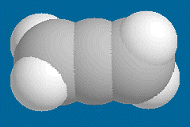 |
| Introduction |
| Symmetry Elements |
| · Proper Rotation Axis |
| · Mirror Plane |
| · Inversion Centre |
| · Improper Rotation Axis |
| · Identity |
| Point Group Gallery |
| Spotting a Chiral Compound |
| · Part I - Mirror Planes |
| · Part II - Inversion Centre |
| · Part III - Improper Rotation |
| · Summary & Conclusion |
| WSM Homepage |
Molecular Symmetry and Chirality
Introduction and Overview
Note: viewing the structures on these pages requires use of
the MDL Chime Plug-In.
The symmetry of a molecule describes how its different parts relate to one another geometrically. symmetry plays an important role in many areas of chemistry, with effects on:
- physical properties: e.g. dipole moment, chirality
- spectroscopic properties: transition intensities, geometric equivalence of groups or nuclei
- bonding interactions: bonds require overlap of atomic orbitals of correct symmetry
| Terms and Definitions |
Symmetry Operation: a spatial manipulation performed on a molecule that leaves it in an configuration identical to and superimposable upon the original configuration.
Symmetry Element: an axis, plane, or point about which a symmetry operation is performed.
Point Group: a symbol that identifies all the symmetry elements present in a molecule.
| Symmetry Elements and Operations |
| Element | Operation | Symbol | ANotes |
| none | identity (no operation) |
E |
|
| proper rotation axis |
rotate by 360º/n |
Cn |
|
| mirror plane | reflection | σ |
|
| inversion centre |
inversion | i |
|
| improper rotation axis |
rotate by 360º/n, then reflect ^ to axis | Sn |
|
| Effects on Molecular Properties |
Chirality:
To be chiral, a
molecule must lack both i and σ.*
Molecules belonging to groups Cn (including E)
and Dn are chiral.
* This is a small oversimplification. The most precise
requirement for chirality is the lack of any Sn element,
but because hardly anybody really knows what those look like, there are a series
of increasingly precise shortcuts used to Spotting
a Chiral Compound. Or, you can just skip to the summary
at the end.
Polarity:
To be polar, a molecule must lack all of i, C2' axes, and σh.
Molecules belonging to groups Cs, Cn (incl E) and Cnv (including C∞v) may be polar.
This page is maintained and copyright by W. Stephen McNeil at UBC Okanagan.
.